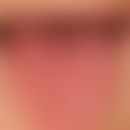Synonym(s)
DefinitionThis section has been translated automatically.
Chronic sensations of discomfort in the oral cavity and/or tongue (chronic oro-lingual dysesthesia), which manifest themselves as extremely unpleasant burning, stinging, tingling, itching as well as a feeling of soreness and other sensations. These symptoms may be associated with disturbed or bad taste (and smell) sensation.
Occurrence/EpidemiologyThis section has been translated automatically.
The prevalence is between 80-120/100,000, with the highest age-adjusted prevalence being found among women between 70 and 80 years of age, at around 500/100,000.
You might also be interested in
EtiopathogenesisThis section has been translated automatically.
Mostly there are psychological causes, e.g. in the context of a larvated depression or involution depression in carcinophobia. Contact sensitization can be detected in about 70% of patients (see below). Secondary occurrence as an accompanying symptom in:
Local factors:
- Exfoliatio areata linguae
- Hairy tongue
- diabetes mellitus
- lingua plicata
- Lichen planus mucosae
- Contact allergies(nickel, palladium, perubalsam, peppermint oil, methacrylates; benzoyl peroxide)
- temporomandibular joint syndrome (Cowden syndrome)
- Glossitis electrogalvanica (with fillings or dentures made of vesch. Metals between which a voltage element is created)
Systemic factors:
- Vitamin B12 deficiency
- Folic acid deficiency
- Glossitis Möller-Hunter
- Iron deficiency anemia (see below trace elements, deficiency symptoms)
- Plummer-Vinson syndrome
- Sjögren's syndrome
- Side effect of beta-blockers.
- Diabetes mellitus (undiagnosed or poorly controlled)
- Vitamin deficiency states of vitamin B1, B2, B6
- Sjögren's syndrome
- Acoustic neuroma
- Xerostomia causing drugs
ManifestationThis section has been translated automatically.
Occurs mainly in women between 45 and 70 years of age, often during and after the menopause. In children this symptom practically does not occur. w:m=4:1.
ClinicThis section has been translated automatically.
Except for tongue burning and/or tongue pain no clinical local findings; only very rarely slight inflammatory redness of the tongue. Typical complaints are a constant feeling of a burned tongue (hot tongue syndrome) and burning or stabbing pain (burning mouth syndrome).
Associated disorders:
Dry mouth (66%)
Flavour disorders (11%)
Often signs of mild depression, insomnia and general listlessness are evident.
The glossodyniae can be classified as follows:
- Type I: Complaints usually begin in the morning and increase during the day. Complaints become unbearable in the evening when fatigue sets in.
- Type II: Continuous symptoms (often combined with contact allergies)
- Type III (most common type): Intermittent pain symptoms.
Many patients have a history of a causal relationship with a previous dental treatment.
HistologyThis section has been translated automatically.
Normal mucosa, no signs of inflammation. Signs of small fibre neuropathy.
TherapyThis section has been translated automatically.
A difficult clinical picture to treat, as often no organic substrate is detectable. An epicutaneous test should be carried out for the relatively high number of contact allergies.
Psychotherapy often does not lead to freedom from symptoms, but should still be discussed.
Important: Continuous care by an experienced, patient doctor is necessary. If necessary therapy of an underlying disease.
External therapyThis section has been translated automatically.
Mild rinsing with stomatological products such as camomile extracts (Kamillosan solution) and
anaesthetic solutions such as benzocaine before meals (e.g. Dolo-Dobendan solution).
Occasionally, artificial saliva products can help, especially in cases of additional dry mouth.
Success has also been achieved with the topical application of clonazepam (Liu YF et al. 2018), 3-minute sucking of a clonazepam 1 mg, tablet, then spit it out, 3 times daily for 14 days (The authors (Gremeau-Richard C et al. 2004) assume a local effect of clonazepam on the benzodiazepine-GABA-A receptor complex in the nerve endings of the tongue mucous membrane which goes beyond the placebo effect).
Internal therapyThis section has been translated automatically.
Initial successes on various drugs such as carbamazepine (e.g. Tegretal) 400-800 mg/day in 3-4 ED (slow dose build-up) or tricyclic antidepressants (e.g. Sarotene) 25 mg p.o. 3 times/day, max. 150 mg/day In the chronic, often years-long course, which dominates both private and professional life, an additional drug abuse may occur.
In the case of complete therapeutic failure, the ultima ratio is mutual blocking of the cervical superius ganglion or the stellate ganglion.
Note(s)This section has been translated automatically.
The glossodynia is a diagnosis of exclusion.
Psychogenic, chronic, oro-lingual dysesthesias are often the somatized expression of a severe, emotionally unprocessed experience of loss (family conflict, loss of partner, climacteric, family disintegration, etc.).
If in such a crisis situation the loss of teeth (prosthesis) is added to the awareness of age, patients who are disposed accordingly react, usually unconsciously, with an oral dysaesthesia symptom.
LiteratureThis section has been translated automatically.
- Al Quran FA (2004) Psychological profile in burning mouth syndrome. Oral Surg Oral Med Oral Catholic Oral Radiol Endod 97: 339-344
- Coculescu E et al (2014) Burning mouth syndrome: a review on diagnosis and treatment. J Med Life 7:512-515
- Dal Sacco D et al (2005) Contact allergy in the burning mouth syndrome: a retrospective study on 38 patients. Acta Derm Venereol 85: 63-64
- Drage LA et al (1999) Clinical assessment and outcome in 70 patients with complaints of burning or sore mouth symptoms. Mayo Clin Proc 74: 223-228
- Formaker BK et al (1998) The effects of topical anaesthesia on oral burning in burning mouth syndrome. Ann NY Acad Sci 855: 776-780
- Gremeau-Richard C et al(2004) Topical clonazepam in stomatodynia: a randomised placebo-controlled study. Pain108: 51-57
- Kohorst JJ et al (2014) The Prevalence of Burning Mouth Syndrome: A Population-Based Study. Br J Dermatol doi: 10.1111/bjd.13613.
- Liu YF et al (2018) Burning mouth syndrome: a systematic review of treatments.
Oral Dis 24:325-334. - Lynde CB et al (2014) Burning mouth syndrome. J Cutan Med Surgery 18: 174-179
- McMillan R et al (2016) Interventions for treating burning mouth syndrome. Cochrane Database Syst Rev 11:CD002779.
- Scala A et al (2003) Update on burning mouth syndrome: overview and patient management. Crit Rev Oral Biol Med 14: 275-291
Incoming links (8)
Burning mouth syndrome; Burning mouth syndrome; Burning tongue; Clonazepam; Stomatodynia; Tongue pain; Trace elements, deficiency symptoms; Vestibulitis, irritative;Outgoing links (21)
Benzocaine; Benzoyl peroxide; Carbamazepine; Clonazepam; Diabetes mellitus skin changes; Exfoliation areata linguae; Field mint; Folic acid deficiency; Glossitis möller-hunter; Lichen planus mucosae ; ... Show allDisclaimer
Please ask your physician for a reliable diagnosis. This website is only meant as a reference.




